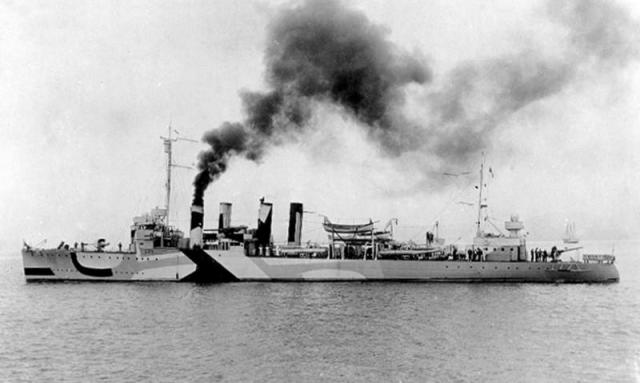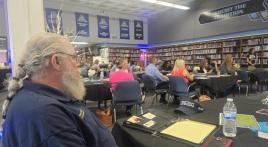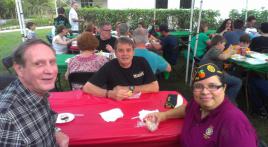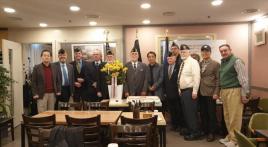Will Lehner entered the Naval Reserves at age 17 in 1938. He was called to active service in 1940 and put on a World War I destroyer, the USS Ward.
The ship "had been in mothballs" for years, Lehner said, so the crew worked to put it back in commission. Afterward, Lehner served in the boiler room and then as a third-class cook.
The Ward set sail for Pearl Harbor, where it patrolled the entrance. There were four "WWI-old" destroyers that would alternate weeks of service. Saturday, Dec. 6, the Ward went out on patrol. Skipper W.W. Outerbridge had taken command just the day before.
"He was just a young lieutenant and never had command before," Lehner said.
At 3:30 a.m. on Dec. 7, the crew was woken up and ordered to battle stations.
"At first we all thought that this was the new skipper. He's just checking us out to see how we work," Lehner said.
After an hour and a half, they went back to bed. But at 6 a.m. they were sent back to general quarters. Lehner's station was aft-ammunition handler. But it was again uneventful - until just after 6:30 a.m.
"The lookout spotted a submarine on the surface, going toward the entrance," Lehner said. "The skipper says our job is to stop anything that's trying to get in the harbor."
At about 6:45 a.m., the Ward fired on that submarine. The first shot, from the No. 1 gun, missed. The No. 3 gun's shot hit the sub between the conning tower and the hull, Lehner said. He saw it roll over and go down.
Lehner said about a half hour later they saw a small boat in restricted waters. The Ward approached and called the Coast Guard, which met the boat to escort it away.
From over a mile out, Lehner said they saw planes diving down and a lot of smoke over Pearl. They figured it was either ongoing construction or Air Force exercises.
"But about that time, two planes and bombers came over towards us, one on each side of the ship, and they dropped bombs on it," Lehner said. "You could see the pilots in them, and we saw the red balls on the plane so we knew. They were Japanese planes, and we said, we're under attack by the Japanese."
The bombs missed the Ward, which kept dropping depth charges until the early afternoon, Lehner said. When they ran out of ammunition, the Ward returned to Pearl to resupply.
"That's when we saw all the damage," Lehner said. "There was oil on the water that was burning. There were bodies on the water. The Oklahoma was overturned, bottom-side-up, West Virginia was down and the Arizona was destroyed. That was burning ... . It was a terrible mess and of course we didn't stay long, we got our ammunition going and got right back out. ... I hope I never see anything like that again."
After the attack, the fear remained. Lehner said they were sure the Japanese "would come in that night and land troops and take over the island." Fortunately, they didn't.
Soon after, the Ward was converted into a fast-transport. Anti-aircraft guns replaced older models, and Higgins boats were added.
The Ward joined the war efforts throughout the Pacific, picking up and landing troops.
Landing forces on Ormoc Bay, Leyte in the Philippines, would be the Ward's final mission. It was Dec. 7, 1944, exactly three years since the Pearl Harbor attack.
Kamikazes dove toward the Ward, Lehner said.
"The third one got through, slammed into us and started a fire," he said. "The ammunition started to explode ... We were dead in the water."
The admiral gave orders to abandon ship.
"But there were about five or six of us that were still aboard ship, trying to save our ship because this had been our home for over three years. ... We didn't want to leave it," Lehner said.
The leadership insisted. If the men didn't leave the Ward, they'd go down with it. Lehner was picked up by a boat near the stern of the Ward.
"I just walked to the back and stepped on the guardrail and got in the boat — didn't even get my feet wet," he said. From there, he was taken to a minesweeper and back to Leyte.
"It so happened that the skipper of that ship that fired the first shot [Dec. 7, 1941] was the skipper that had to fire the shot to sink the Ward, W.W. Outerbridge," Lehner said.
The Ward crew gathered and was shipped back state-side. Lehner spent months in an Oakland hospital recovering from battle fatigue. He received a medical discharge in 1945, ending his plan to make a career of the Navy.
He returned to St. Paul, Minn., and enrolled in school. But none of his classmates believed the Ward had sunk a sub at Pearl Harbor just before the attack. There was no record of that.
Decades flew by. Lehner got married, raised a family, moved to Wisconsin and eventually retired.
Then in 2000, National Geographic and Bob Ballard, the man who found the Titanic, launched a quest to find the sub. Lehner was invited to go along. He spent 14 days with the crew searching for it.
Also aboard: Kichiji Dewa, a Japanese WWII veteran, who served on a mother-sub "that brought the mini-subs over to Hawaii piggy-back," Lehner said.
Lehner baked him a cake for his birthday on the ship.
"We're friends, we can be friends now. We both had a job to do. He joined the Navy when he was young. I joined the Navy when I was young, and we did our job, what we had to do," Lehner said.
However, Lehner said Ballard's team was searching too far out. The funding was cut before the sub was found.
In 2002, the University of Hawaii and Terry Kerby decided to take two submersible submarines down 1200 feet, certain he'd found the sub. Lehner joined.
They located the submarine the Ward sunk more than 60 years earlier.
"It was such a relief," Lehner said.
The Ward's No. 3 gun is on display outside the Veterans Service Building in St. Paul.
For another account of the attack on Pearl Harbor, read Ed Johann's story: http://www.legion.org/stories/my-time-uniform/pearl-harbor-hero-recalls-...





